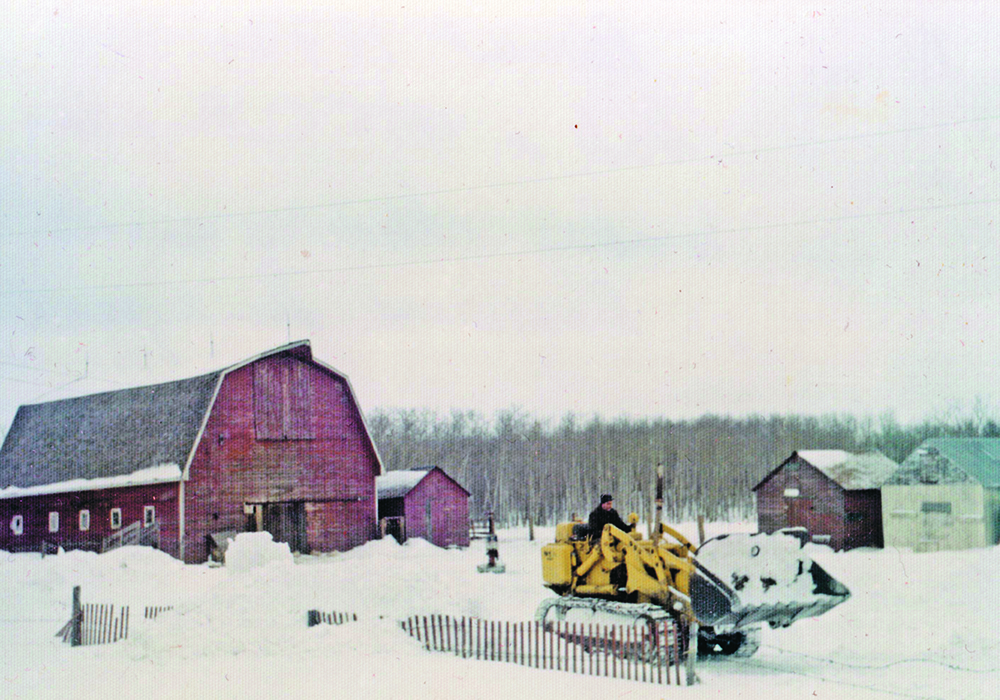There was nothing like a stuck tractor, especially one driven by Dad, to create instant drama for these Manitoba farm boys
I just don’t know why. I can’t explain. I do know, though, that as a young farm boy in the 1970s, a stuck tractor, especially in the mud, meant instant entertainment and excitement.
It was even better if Dad was the one who got the tractor stuck, but I don’t know why.
As farm boys at Basswood, Man., during the early 1970s, we never got chance to drive a big tractor close to a slough to get the machine bogged down stuck. Dad did the fieldwork and as his tractors got bigger, and therefore the implements wider, he could “reach” further into the wet spots.
Read Also

Canadian Food Inspection Agency extends chronic wasting disease control program consultation deadline
Date extended for consultation period of changes to CWD program
I do recall once, riding along on the fender, when he got too close with his 65 horsepower Deutz and the 18-foot Glencoe cultivator. Before he could hydraulically lift the cultivator and steer away, he was mired in deep black mud. The far end of the cultivator was tilling stinky slough water. Yuck! This 10-year old loved the unfolding events.
Dad pulled the lever to lift the implement, but the cultivator wheels merely sank into the soggy ooze. Nothing doing.
Dad sprang into action. Without stepping onto the ground, he gingerly got off the back of the tractor, walked onto the hitch and bolted a strap that held the cultivator in the “up” position. He then unhooked the hydraulic hoses, pulled out the hitch pin, and returned to the seat. The Deutz had a magical lever, the differential lock, which meant one wheel could not spin alone. Both drive wheels had to pull together.
I sat calmly to await further drama. Dad put the green tractor in gear and let out the clutch. I hoped we would be still stuck. Alas, the tractor began to move — slowly, but perceptibly. Dad kept the front wheels straight to decrease resistance. With both drive tires locked, the Deutz edged away from the wet spot.
Then on high ground, and with four tires encased in mud, Dad steered the tractor backward at a right angle to the cultivator hitch. He stopped about 20 feet away, still on dry ground. What now?
Dad played his ace “get out of the mud-hole” card. He grabbed a logging chain stowed on the tractor. He hooked one end to the cultivator hitch and the other end to the tractor. With the tractor on high ground, and with the lesser drag of the cultivator turning and lifting out of the ground, the Deutz pulled it out of the mud.
Too easy. I had hoped for a longer scenario, possibly involving another tractor and hours of action.
On the next pass, Dad drove carefully, reached over with the end of the cultivator and obliterated the tractor’s tell-tale muddy ruts. Nobody would know the episode. I couldn’t bring any of my brothers by for a “play-by-play” replay. The evidence was gone.
A year later, just after seeding, Dad got fed up with a wet spot that wouldn’t drain. He went and got his 955 Caterpillar track loader to sculpt a ditch. This was serious. We four brothers, aged 12 to 6, pretended to pick stones close by, but we were watching what might unfold. Maybe Dad would get stuck. We could only hope.
Dad worked the machine back and forth, fashioning a shallow ditch. Soon, the moment of truth — Dad’s Cat would break through the mud ridge and allow the standing water to drain. We couldn’t get more excited.
Dad bulldozed through the isthmus barrier and two feet of water flowed quickly around and under the Cat and into the drainage ditch. Then Dad went to back up. Nothing happened. The tracks spun. He was stuck.
Fantastic. We brothers could not have imagined a better stuck in the mud story. We practically jumped up and down, cheering for the mud hole. The sure-footed Cat loader was not only stuck, but Dad was trapped on it too. What to do?
Before we could think, Dad put the loader in low gear, and using the tilt action of the big gravel bucket, he pried the machine forward, maybe a foot at a time. After about six manoeuvres like this, the loader’s metal tracks found traction and it began to move. OK, fine. However, Dad was heading into the water, not out of it.
Dad knew his machine though. His loader had just enough power, weight and traction to move. If Dad had tried to steer it (disengaging the track clutch on one side), the loader would have lost traction. So Dad patiently drove straight through the slough.
Oh pooh.
We wanted Dad to have wet feet. He parked the loader and came over. He suggested the Cat had performed better than he figured, slugging though the quagmire. We didn’t want to hear it. We wanted chains, cables, timbers, and tractors and the roar of diesel power under duress. Maybe even get the neighbours’ tractors involved.
The bonus was that as the water drained, it exposed two deep long ruts which lasted all summer. The “muddy Cat” tale lived on.
A few Septembers later, we had it all happen. Or rather, a neighbour experienced it all.
It seems a neighbour’s son had taken a shortcut through a harvest field while pulling a wagonload of grain. In his haste in the darkness, and with his poor eyesight, Allan drove into a slough, with speed and mass, and therefore, deeply. In other words, he got the tractor stuck with considerable enthusiasm.
Mom heard about it on the phone after church. Could Dad bring strong cables and big pulleys and come on by? Cables? Pulleys? This should be good.
Immediately, older brother David and I lobbied Dad to join him.
“Only if you stay way back,” Dad ruled. Off we went in Dad’s blue pickup.
We drove along until Dad spotted a collection of pickups and tractors on a lower corner of a field. He turned in. The owner was there, looking forlorn, but the son was nowhere to be found. He had left the scene of his muddy “crime.”
We joined other farmers. Things were well underway. The owner’s 730 Case tractor was in deep with the front wheels buried. The rear tires were at least halfway covered. Farmers had hooked three cables onto the rear hitch and had slung those cables over big posts set into the ground. The idea was to both pull and lift the tractor out.
Dad’s pulley idea, to double the power of a tractor, was dismissed. There was enough power here to tear the 730 apart. Ideas, discussion and mild dissension reigned. What about logs? Who will co-ordinate the combined pull of three tractors? Should the stuck tractor have a driver, or just put it in neutral? The Great Mud Extraction was set to debut.
Suddenly, like a big dog joining a fight late, another neighbour’s son arrived with a four-wheel drive Versatile. The red tractor was new to the district and featured 118 horsepower, slightly less than the three tractors combined. The driver hitched up to a cable as a smaller tractor, a Case 400, was dismissed. Let the pull begin.
In a roar of Rudolf Diesel’s invention, the Versatile driver jumped the gun and had the 730 yanked out before the others had even tightened their cables. This was great, what action. Finally, a decent stuck tractor story.
The farmers then had to discuss what had happened. The Versatile was so impressive. A salesman could have written up some business.
Dad packed up his pulley and we headed home. David and I had conversation fodder for the weeks ahead. Dad reminded us not to criticize Allan too much.
“Anybody could have driven into that slough at night,” he surmised.
In the late 1970s, I had to use Dad’s method of getting the tractor unstuck while cultivating the summerfallow. I always left the farmyard with a chain. And I always cultivated over my muddy ruts so nobody would notice the evidence. My stuck tractor fun had disappeared.















